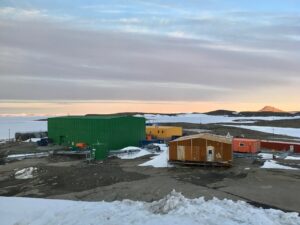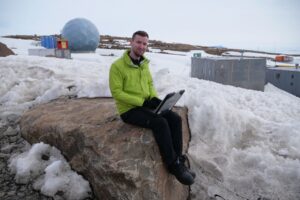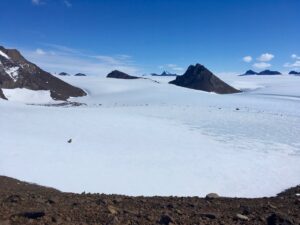Last week a small group of us summer expeditioners who had not yet been out to Auster Rookery to see the Emperor Penguins kept a close eye on the weather forecast. We were desperately hoping for a clear day before the weekend, as the sea ice that far away from station was due to close on Saturday. We woke up on Friday to clear skies and good winds were telling us it was going to be a good day – definitely time to get out there while we could!
It’s a fairly long trip of about 60kms east of station, so we all jumped in the Hagglunds and off we went. As we got closer to Auster there are many, many large icebergs stuck in the ice, and it’s quite a bumpy part of the trip as the icebergs slowly shift and push the fast ice around throughout the year.
We parked a good distance from the colony and walked in carefully. There are clear approach distances we need to adhere to so as not to disturb the breeding birds. Once I found a nice spot I got down on the ice and quietly sat there watching the birds wander in and out of the rookery.
Being the middle of the day and full sun the birds were quite hot! Apparently they were not as curious as they usually are compared to previous visits as they flapped their wings to cool off, or just lazed around on the ice. Still, a lot of activity in the group though and the occasional adult wandering past, heading out to the sea for a feed.
We spent about two hours watching the birds. It’s an incredible sight to be so close to an Emperor Penguin colony. I snapped pictures and took some shots for a video, but it doesn’t quite capture the sense of the warm sun, the gentle breeze, and the adorable calls from the jouveniles wanting some lunch from their parents. This has definitely been the biggest highlight from this season so far. I could have spent hours just sitting there enjoying the whole thing.
We eventually did have to head home, and we topped of an amazing trip by visiting a jade iceberg on the way home.


















